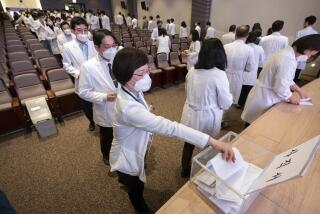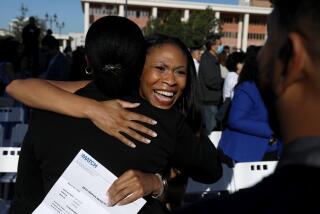FRONT-LINE DOCTORS
- Share via
First-year medical student Hannah Segal sees the same patients and finds herself managing the same ailments during her frequent visits to a community health clinic on downtown Los Angeles’ skid row.
It’s not the most glamorous or desired duty among her USC classmates, many of whom aspire to prestigious, high-paying medical specialties. But her work on the front lines of patient care has helped Segal find her passion. “I’m always really excited to come here,” she said. “I get to really problem-solve over time.”
The program that brought Segal to this clinic is part of a new nationwide push to address a chronic problem: the U.S. is failing to produce enough family doctors to meet current and future needs.
To address the shortage, new medical schools are opening with an emphasis on primary care and others are changing their curricula to boost the number of graduates interested in the field. Medical school professors are pairing students with family doctors and assigning them to community clinics so they see firsthand what it’s like to practice preventive care and manage chronic diseases.
The vast majority of U.S. medical school students have long pursued careers as neurologists, cardiologists or other specialists, resulting in an acute shortage of primary-care physicians that will only get worse as more family doctors retire.
The search for solutions is taking on new urgency because healthcare reform will provide an estimated 30 million more Americans with health coverage in two years. And fielding more family physicians is key to the savings promised by backers of the healthcare overhaul.
Without the preventive care and disease management provided by general practice doctors and internists, patients often require more extensive, costlier treatment by specialists and emergency room physicians.
“It is an extremely critical problem,” said Russell Robertson, chairman of the Council of Graduate Medical Education, which advises the government on physician workforce issues. “It is certainly contributing to the high cost of healthcare.... It is a worrisome thing to see how this is going to unfold.”
The American Academy of Family Physicians estimates that the nation will be short 39,000 primary-care doctors by 2020.
Experts say changes at medical schools will do only so much, given the long-standing pay gap between primary-care doctors and specialists, which is estimated to reach $3.5 million over a lifetime. To help, the federal government is joining the effort, allocating more resources to recruitment, training and reimbursement for primary-care providers.
Baby boomers’ aging is exacerbating the problem, said Carmen Puliafito, dean of USC’s Keck School of Medicine. “Who is going to take care of these people?” he said. “We don’t have good answers to those questions yet, as a nation and as a medical profession.”
Segal is one of 12 students in the university’s longitudinal program, in which students can spend their entire four years of medical school working in community health clinics. Students are more likely to consider primary care professions if they get experience forming relationships with patients and treating their illnesses, said Segal’s mentor, Paul Gregerson. He is medical director of the nonprofit John Wesley Community Health Institute, which runs several clinics, including the one on skid row where Segal works.
Gregerson said he hopes students like Segal will help alleviate the shortage that is making it nearly impossible to find doctors to work with the poor and uninsured. “The biggest problem is getting qualified people who have the education and desire to work with this population,” he said.
Wearing a white coat imprinted with her name, Segal sat with Gregerson and a 48-year-old patient who was obese and had a history of hypertension. They explained the risk of heart disease and talked with him about the importance of controlling his weight and blood pressure.
Later, Gregerson helped Segal complete the patient’s medical chart, advising her to jot down his blood pressure and to note that he was bicycling regularly and trying out a low-carb diet. “Next time you come you already have a few things to talk about,” he said. “It’s a really good way to connect with your patients.”
The key to getting more graduates to pursue community medicine is recruiting the right students, said G. Richard Olds, dean of UC Riverside Medical School, which is waiting for accreditation and expects to focus in part on primary care. Olds said that means reaching out to applicants from diverse backgrounds who are committed to serving their communities.
Christina Thabit, from Bakersfield, wants to do just that. She saw firsthand the shortage of doctors to treat her father, who had multiple sclerosis. “I have seen all the battles,” she said. “I want to make that better.”
Thabit is among the first students in a new medical school program run by UC Davis and UC Merced that aims to increase the number of doctors in the San Joaquin Valley.
Around the nation, schools have opened in Florida, Pennsylvania and Connecticut with an emphasis on family medicine. Harvard University also recently opened a Center for Primary Care to improve teaching and research.
If there is a stronger system of primary care in the U.S., “the better quality of care we are going to provide and at a lower cost,” said Russell Phillips, one of the interim directors of the center.
Eric Lu, 24, who plans to go into family medicine, said he is drawn to the field because he can become a gatekeeper for patients as they enter the healthcare system and a guide as they move through it.
“I see the importance of having physicians who are able to really understand patients as people as a whole, not just as individual disease entities,” Lu said.
For many, however, the allure of primary care is outweighed by the downsides. Many family doctors have large patient loads and work long hours in private practices or community clinics.
In addition, most healthcare is paid for based on the service provided, and managing chronic diseases and counseling patients on how to live healthier lives isn’t typically lucrative. Family doctors earn from $175,000 to $220,000 -- about half the annual salary of specialists, according to the American Academy of Medical Colleges.
With about $160,000 in educational debt, medical school graduates can’t be blamed for wanting higher-paying jobs, said Atul Grover, chief public policy officer of the academy.
“If you are looking at uncertainty and a less attractive practice environment and less money, it is hard to convince people to go into primary care,” Grover said. “You can’t hide the realities of how difficult practice lives are.”
Lu, the Harvard student, isn’t discouraged. “I get to do something that I am passionate about,” he said. “It’s worth it.”
--
More to Read
Sign up for Essential California
The most important California stories and recommendations in your inbox every morning.
You may occasionally receive promotional content from the Los Angeles Times.













